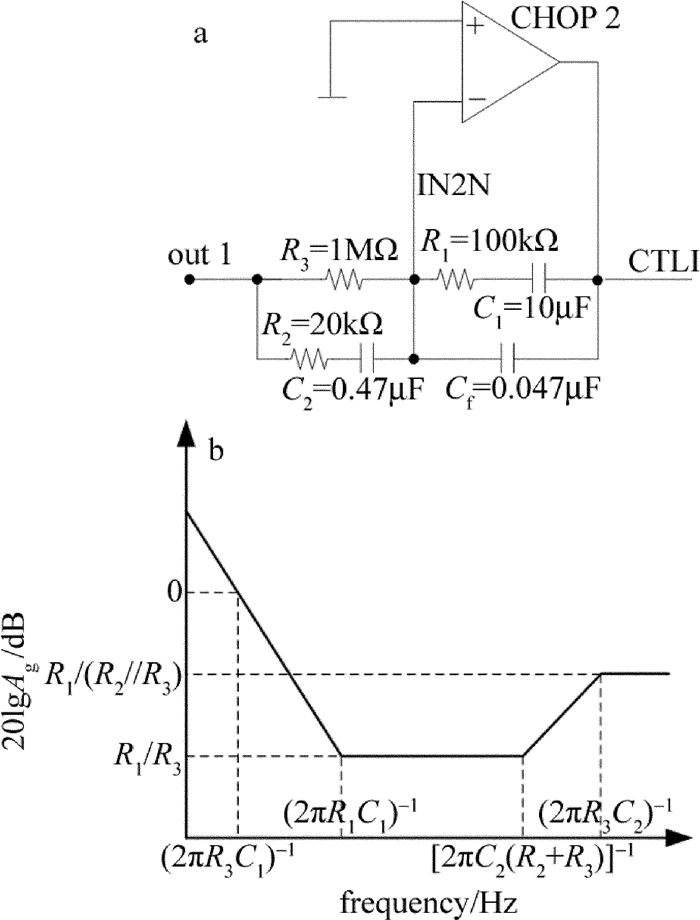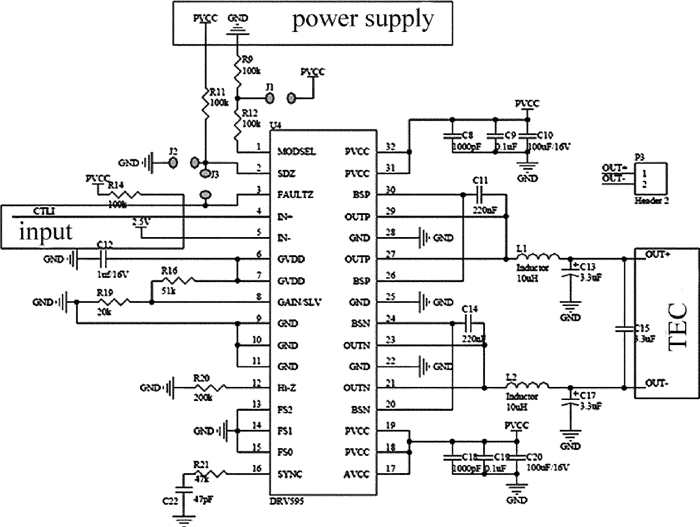HTML
-
激光二极管(laser diode, LD)因其成本低、体积小、重量轻等优点在激光设备中广泛应用[1-2]。LD的缺点是受温度影响大[3-4]。阈值电流、功率随温度的变化发生漂移,发射波长随温度的变化约为0.3nm/℃~0.4nm/℃[5-6]。目前固体激光器的吸收谱线带宽窄,因此,实现对LD的恒温控制在激光应用中尤为重要。
半导体热电制冷器(thermos electric cooler, TEC)是利用半导体材料的珀尔帖效应制成的热泵, 体积小、重量轻,适用于小型温控系统。通过调节TEC电流或电压实现精确控温,因此,TEC本身性能的好坏直接影响温控精度。当前,国外处于领先水平的公司如Analog Devices和Maxim分别推出TEC控制芯片ADN8830和MAX1978,均可实现0.01℃的激光器温控精度。由于其驱动电流均小于3A,无法满足该系统较大功率制冷要求。使用大电流恒流源驱动TEC的方法,虽然最大电流可达7.5A[8-9],但采用单向电流控制,会出现轻载电流非线性甚至温控死区的问题。本设计中采用金属氧化物半导体场效应管(metal oxide semiconductor field effect transistor, MOSFET)构成的H桥驱动TEC,通过脉冲宽度调制(pulse width modulation, PWM)控制H桥的方向和导通时间, 实现对TEC的高效率、无死区控制。集成电路DRV595内部集成PWM和MOSFET的H桥,通过和外接基准电压的差值产生脉冲波,内部实现控制H桥电流方向和开通时间,从而驱动TEC。从外部看,DRV595的输出正比于输入,相当于控制器中比例-积分-微分环节(proportional-integral-di-fferential,PID)的比例(P)模块,建模简单。
-
LD温控系统图 1所示。这是一个经典的PID控制系统,由控制单元、执行单元、反馈单元组成的闭环系统[10]。LD的温度可以通过热敏电阻阻值反映,本系统反馈单元为负温度系数(negative temperature coefficient, NTC)的热敏电阻和3个精密电阻组成的电桥。采样和基准的差分信号经过集成运算放大器放大50倍,输入到PID,PID控制器作为控制单元,其输出控制执行单元集成电路DRV595,在TEC两端输出相应的电压差,制冷或加热,达到控制LD温度的目的。热敏电阻对温度比较敏感,为避免热敏电阻自身发热,影响测温精度,流过本系统热敏电阻的最大电流不超过1mA。差分信号放大部分采用2.5V作为基准,而非0V,是因为防止该电路不可放大负差分电压。而控制系统稳定时不可避免的在基准电压上下浮动。此2.5V基准电压和DRV595驱动单元中的2.5V基准电压互消,输出至TEC两端的信号仅和差分信号相关,不再受基准电压的影响,从而实现正负差分信号的放大。
-
整个系统涉及的环节较多,在时域不便分析,在S域(复频域)建立各模块的数学模型。由图 1可知,TEC为系统的执行结构。TEC的工作原理如图 2所示[11-12]。设TEC的制热系数为E,传热系数为k,接触面积为A,初始温度为T0,制热后的温度为T1,单位时间内制冷器产生的热量为ΔQ。由能量守恒定律可得:
式中,U表示TEC两端电压,R表示TEC的电阻值。可知Q和U成非线性关系, ΔT=T1-T0,ΔU为TEC两端温度变化后电压的变化值:
转化为S域的方程为:
令$ \frac{{\Delta Q}}{{\Delta UkA}} = P, \frac{E}{{kA}} = {\tau _1}, \frac{{\Delta T}}{{\Delta U}} = G\left( s \right), G(s)$为TEC在S域的传递函数, s是复频率。
(5) 式表明, TEC为1阶惯性环节[13-14]。测量反馈单元近似为比例环节[14], 即系统的反馈传递函数H(s)=K, K是比例系数。半导体激光器温度是一个缓慢变化的过程,控制对象LD的传递函数为1阶惯性环节[14],则执行结构和控制对象为一个双极点系统。本文中采用MAX1978中的TEC双系统模型,极点可近似为0.01Hz和1Hz。其对应波特图如图 3所示[15]。
-
为保证系统的温控性能,采用经典PID控制。PID控制器的经典电路结构及其波特如图 4所示。由PID控制器补偿之前的波特图如图 3所示,按照自动控制原理中波特图补偿步骤[15]。考虑到相位裕度等性能指标,补偿电路的第1个拐点频率为0.16Hz,第2个拐点选择穿越频率为1.5Hz,第3个拐点频率为7.5Hz。PID控制器的配置电阻电容取值见图 4a[15],图 4b为图 4a对应的幅值, 即增益的波特图,纵坐标表示20lgAg,其中Ag为图 4a对应的传递函数的增益。
2.1. 子模块建模
2.2. PID控制器设计
-
DRV595是一款高效、高电流的功率驱动器。单电源供电,供电范围4.5V~26V,最大可产生±4A的输出电流,内部PWM方式运行和低输出级电阻大大降低了放大器内的功率耗散,广泛应用于TEC驱动。DRV595内部高达1.2MHz的开关频率,外围滤波需要的电容值变小,从而减小了整个电路印制电路板(printed circuit board, PCB)尺寸,达到小型化的目的。
PWM功率放大器可分为三部分:控制电路部分、电压-脉宽转换电路部分、开关式功率驱动电路部分。DRV593采用了先进的PWM技术,其电路包括输入控制部分、三角波发生器部分、H桥电路驱动逻辑控制部分以及H桥电路。各引脚号、引脚定义、功能如表 1所示[16]。
name of pin description SDZ shutdown logic input IN+, IN- positive and negative differential input GND ground Hi-Z input for fast disable/enable of outputs FS2, FS1, FS0 frequency selection input SYNC clock input/output for synchronizing multiple devices PVCC power supply BSP, BSN boot strap for negative and output OUTP, OUTN output Table 1. Pin definition and function
设置后的TEC驱动电路如图 5所示。虽然DRV595采用脉冲宽度调制,但是最终输出的是连续变化的模拟量与控制端输入电压信号成线性关系。图 5中R19的阻值为20kΩ,R16不焊。DRV595的输出电压和输入电压关系式[16]为:
式中,取K=10,在S域中为比例环节。
-
在外界环境温度为19℃、稳定温度为25℃时, 当激光器温度稳定情况下, 每2min记录一次,连续记录20个数据, 该温度值如表 2所示。从表中可知温控的精度为±0.03℃,工作稳定,满足系统要求。
time/min temperature/℃ 2 24.983 4 24.982 6 24.999 8 24.010 10 25.019 12 25.018 14 25.023 16 25.021 18 25.029 20 25.028 22 25.014 24 25.023 26 25.010 28 25.014 30 25.025 32 25.004 34 25.021 36 25.007 38 25.015 40 24.99 Table 2. Temperature of laser diode
-
对整个温控系统分模块进行了建模,并分析了PID补偿控制网络。TEC的驱动采用专门PWM驱动芯片DRV595,对TEC模块进行双向电流控制,并且最大输出电流为±4A,避免了控制死区和小负载非线性的问题。实验结果证明,本系统的控制精度为±0.03℃,能够满足半导体激光器的温度控制要求。

 Map
Map




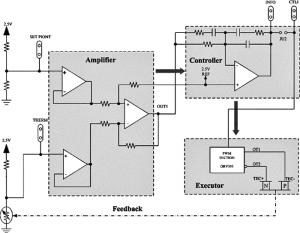
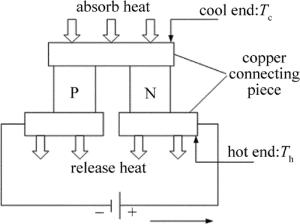


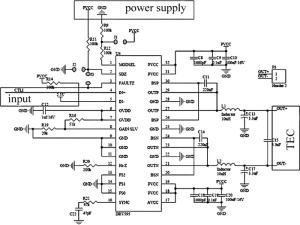
 DownLoad:
DownLoad:


